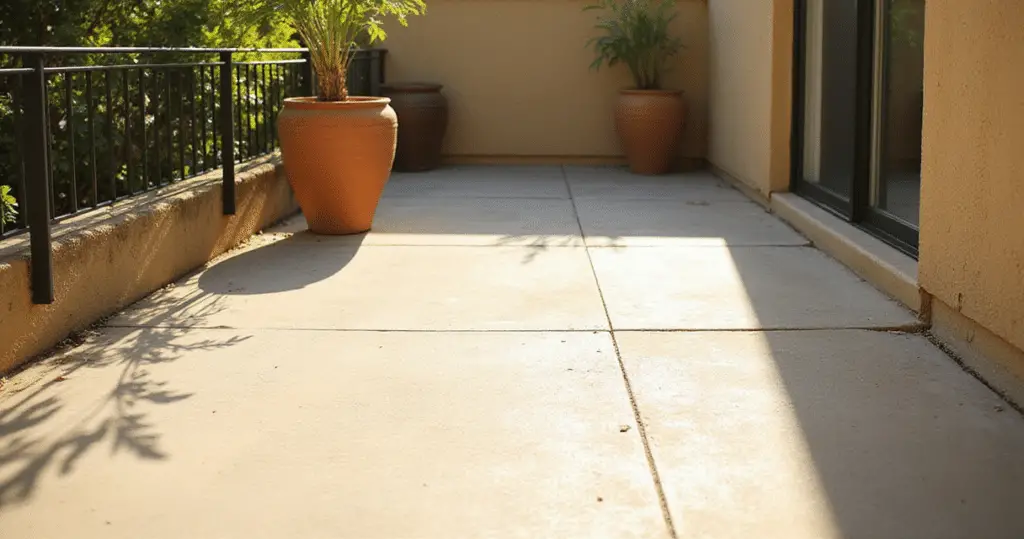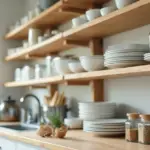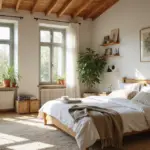Your patio holds untapped potential – a canvas waiting to be transformed into a living, breathing extension of your home. As a modern zen design expert, I’ve seen how even the smallest concrete slab can become a sanctuary of green tranquility with the right approach to patio gardening.
The beauty of container gardening lies in its accessibility and adaptability. Whether you have a sprawling terrace or a tiny apartment balcony, these principles will help you create a space that nourishes both plants and your sense of wellbeing. Let’s explore how to merge traditional Japanese minimalism with practical patio gardening techniques for a space that feels both abundant and serene.
1. Assess Your Sunlight: Finding the Best Spot
The inspiration for this collection of tips struck when I noticed how many patio gardens fail not from lack of care, but from mismatched light conditions. Light is the lifeblood of plants, and understanding how it moves across your space throughout the day is fundamental to success. Different plants have vastly different light requirements – from sun-worshippers needing 6+ hours of direct light to shade-lovers that wilt under intense rays.
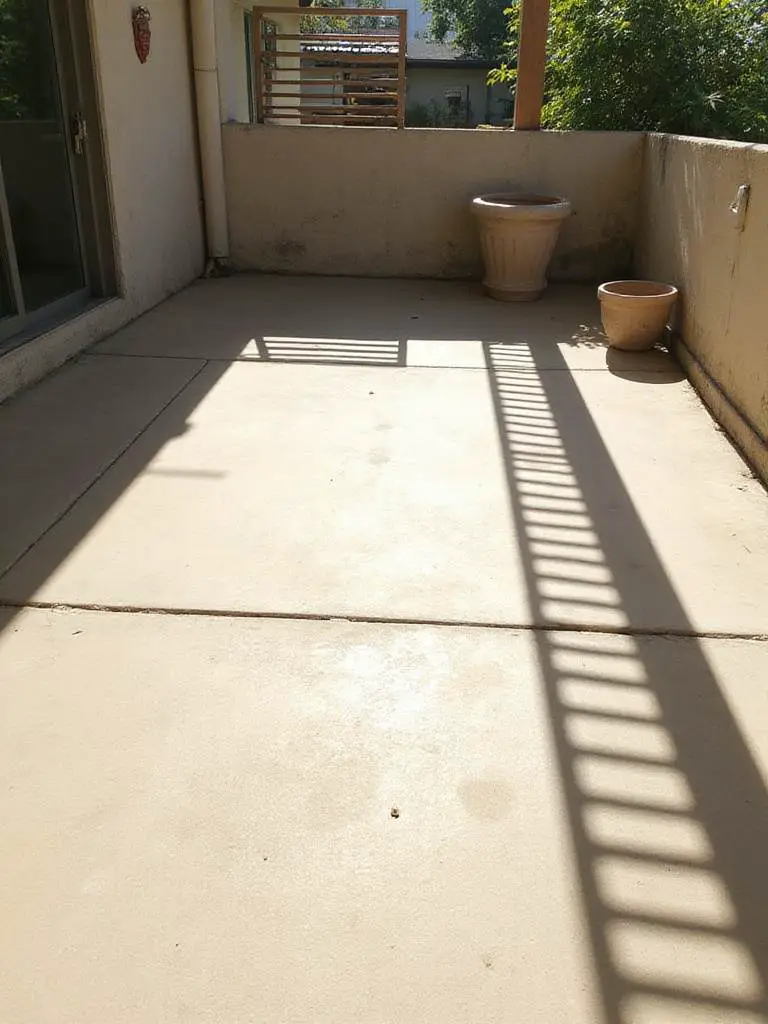
Take time to observe your patio at different hours. Create a simple sun map by sketching your space and marking areas as “Full Sun” (6+ hours direct sunlight), “Partial Sun” (3-6 hours), or “Shade” (less than 3 hours). This visual guide becomes your blueprint for plant placement, ensuring each green companion finds its ideal home.
The magic of this piece lies in its simplicity – a sun map costs nothing to create but dramatically increases your chances of patio gardening success by matching plants to their preferred light conditions.
2. Choose the Right Containers: Size and Drainage Matter
Beyond aesthetics, your container choice fundamentally shapes your plant’s life experience. The designer’s attention to detail shows in selecting pots that offer both beauty and functionality. A container that’s too small restricts root development, while one that’s excessively large can retain too much moisture. Either scenario stresses your plants and limits their potential.
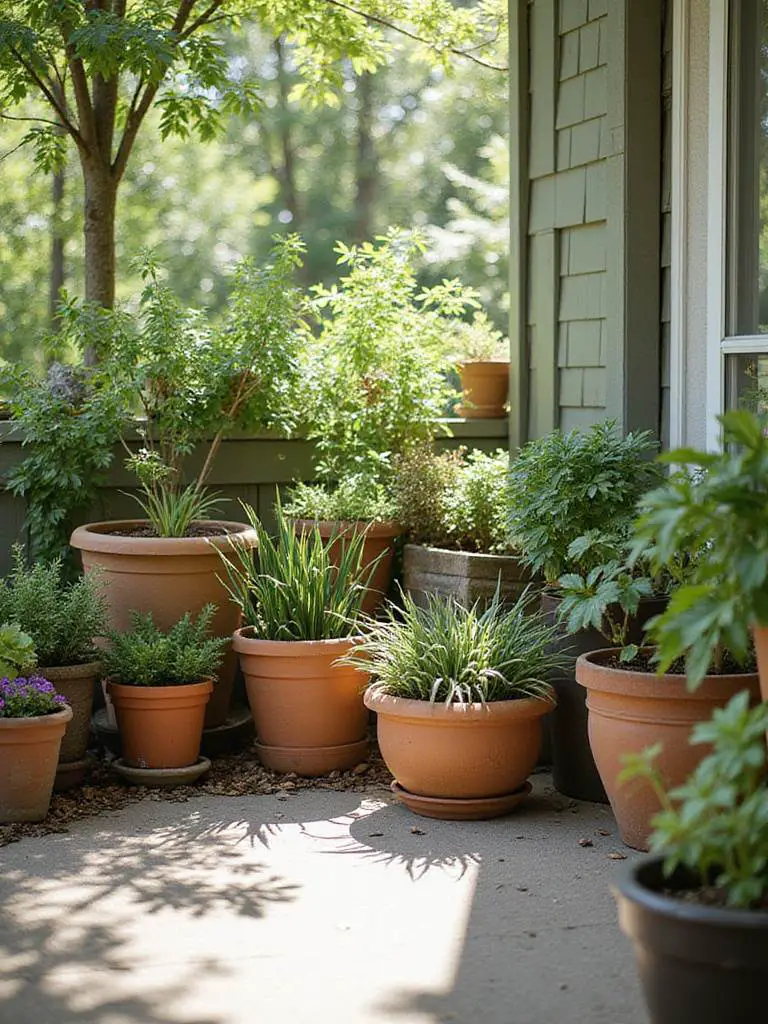
Drainage is non-negotiable. Without proper drainage holes, excess water has nowhere to escape, creating a deadly environment where roots suffocate and rot. This simple feature – holes in the bottom of your container – makes the difference between thriving plants and a disappointing experience. If you fall in love with a decorative pot lacking drainage, use it as a cachepot (an outer decorative container) with a properly draining pot nested inside.
“The container is not just a home for your plant – it’s the foundation of its entire ecosystem. Choose wisely, and your plant will reward you with vigor and beauty.” – Kai Nakamura
The craftsmanship reveals itself in details like proper sizing and drainage – elements that might seem minor but dramatically impact your patio gardening success as you move forward to the next crucial decision: what to fill those containers with.
3. Select Quality Potting Mix, Not Garden Soil
The environmental story behind potting mix began with the recognition that container plants have fundamentally different needs than those growing in the ground. Garden soil, while teeming with life, becomes problematic in containers – it compacts easily, drains poorly, and may harbor weed seeds or pathogens. Quality potting mix, by contrast, is specifically engineered for container life.
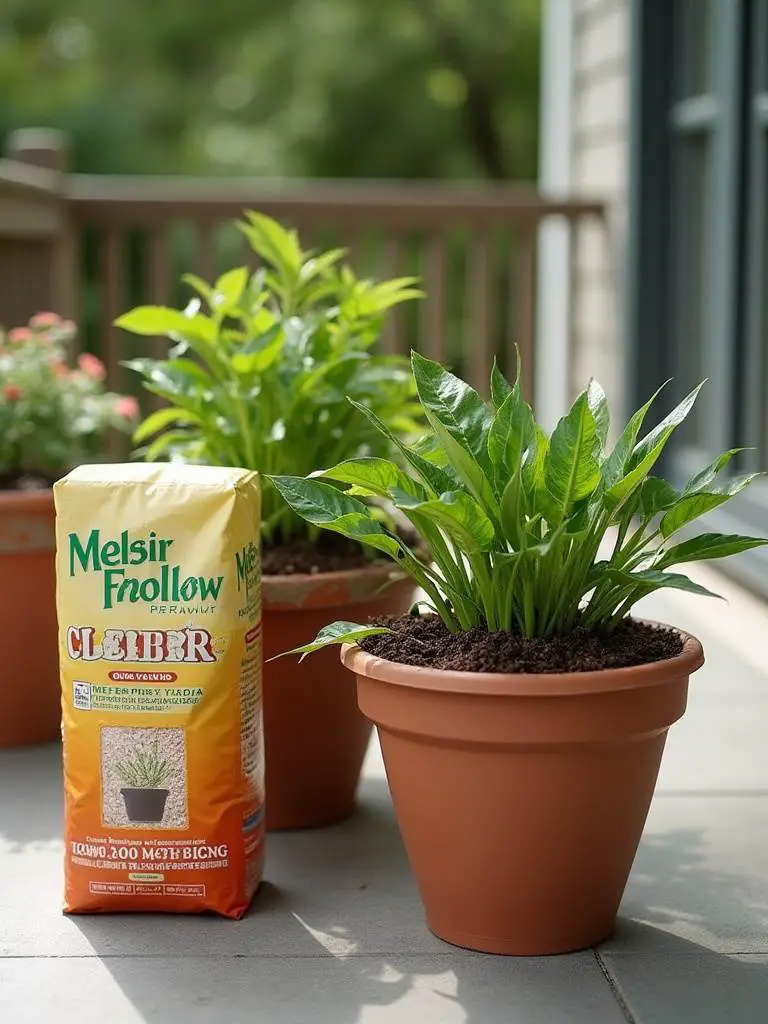
A good potting mix contains ingredients like peat moss or coir for structure, perlite or vermiculite for aeration, and sometimes slow-release fertilizers. This lightweight, sterile medium provides the perfect balance of moisture retention and drainage that container plants crave. The investment in proper potting mix pays dividends in plant health, requiring less intervention and troubleshooting later.
- Components of quality potting mix:
- Peat moss/coir: Provides structure and moisture retention
- Perlite/pumice: Creates essential air pockets for root breathing
- Vermiculite: Helps retain nutrients and moisture
- Composted bark: Adds organic matter and improves structure
- Starter nutrients: Feeds plants during establishment
Unlike conventional options, this approach reduces the risk of soil-borne diseases and creates an optimal environment for roots to explore and expand throughout your patio gardening containers.
4. Water Wisely: How Much and How Often?
The unexpected environmental benefit comes from mastering the art of watering your patio garden. Most container plants die from overwatering rather than underwatering, making this skill particularly crucial. The finger test remains the most reliable method – insert your finger about 1-2 inches into the soil. If it feels dry at that depth, it’s time to water. If it’s still moist, wait.
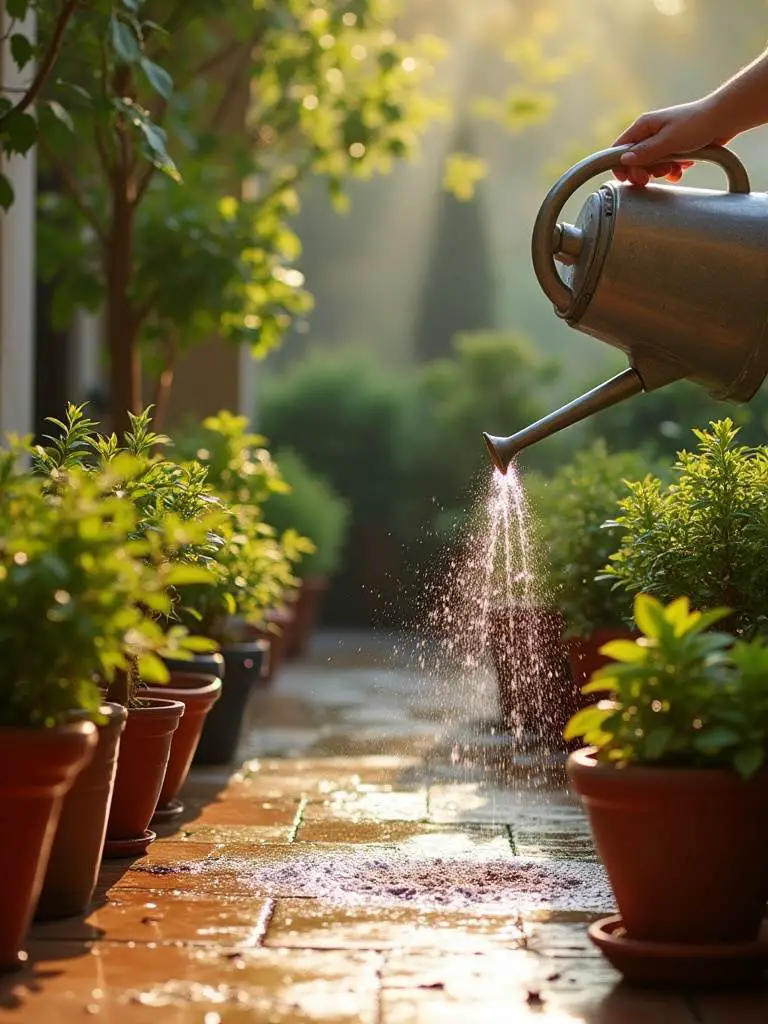
When you do water, do so thoroughly until moisture flows from the drainage holes. This ensures the entire root ball receives hydration, not just the surface. Shallow watering encourages weak, surface-level roots rather than the strong, deep root systems that help plants weather dry periods. The frequency depends on multiple factors: container size and material, plant type, weather conditions, and season.
The unexpected pairing that always works is grouping plants with similar water needs together. This prevents the common scenario where drought-tolerant plants suffer from the frequent watering their thirsty neighbors require. Your patio gardening routine becomes more efficient and plants thrive when their specific moisture preferences are respected.
5. Feed Your Plants: Understanding Fertilizers
What makes this choice better for our planet is understanding that container plants need regular feeding. Unlike garden plants that can send roots far and wide in search of nutrients, potted plants rely entirely on what’s available in their limited soil volume. The nutrients in potting mix deplete quickly, especially with frequent watering which leaches them out.
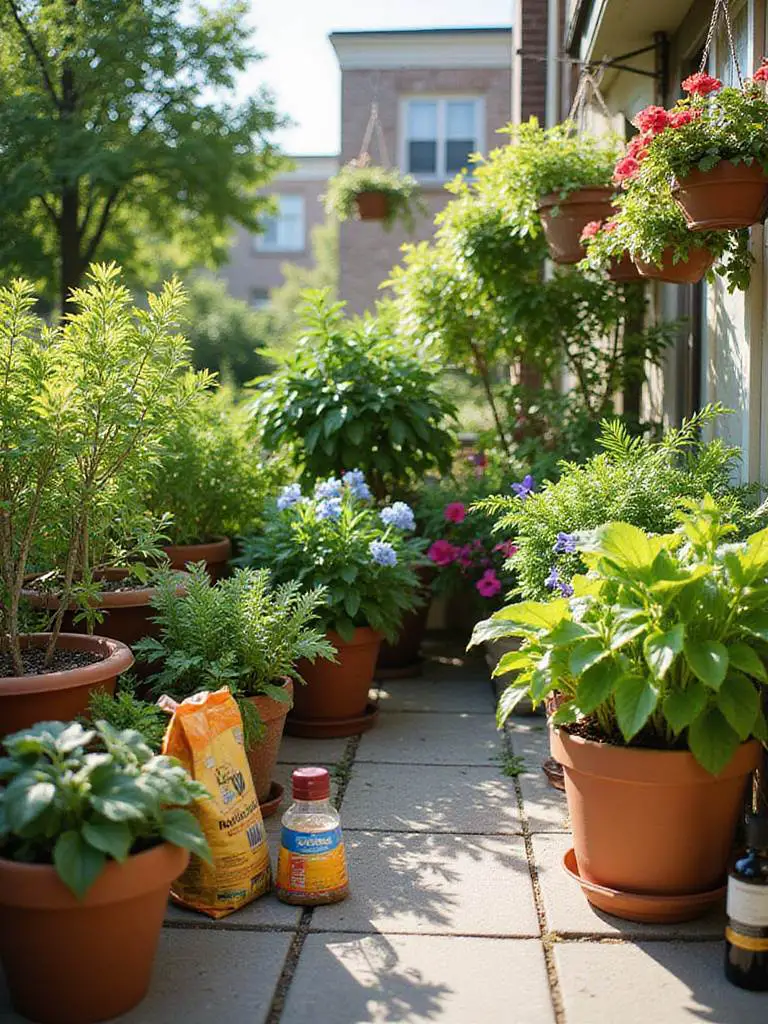
The three numbers on fertilizer packages (like 10-10-10) represent the N-P-K ratio: Nitrogen for leaf growth, Phosphorus for roots and flowers, and Potassium for overall plant health. For most patio gardening situations, a balanced fertilizer works well, though flowering plants may benefit from formulations with higher middle numbers. Consider slow-release granules for convenience or liquid fertilizers for quick results.
- Signs of nutrient deficiency:
- Yellowing lower leaves (often nitrogen)
- Purple leaf undersides (often phosphorus)
- Leaf edge browning (often potassium)
- Stunted growth despite adequate light and water
- Poor flowering or fruiting
The styling mistake most people make is applying too much fertilizer rather than too little. “Feeding” plants actually means providing minerals they convert to food through photosynthesis – overdoing it causes fertilizer burn and environmental runoff.
6. Pick Plants Suited to Containers and Your Climate
The artisans behind these designs began with understanding that not all plants thrive in the confined space of containers. The best candidates for patio gardening typically have compact growth habits, non-invasive root systems, and tolerance for the fluctuating moisture and temperature conditions containers experience. Dwarf varieties of larger plants often perform exceptionally well in pots.
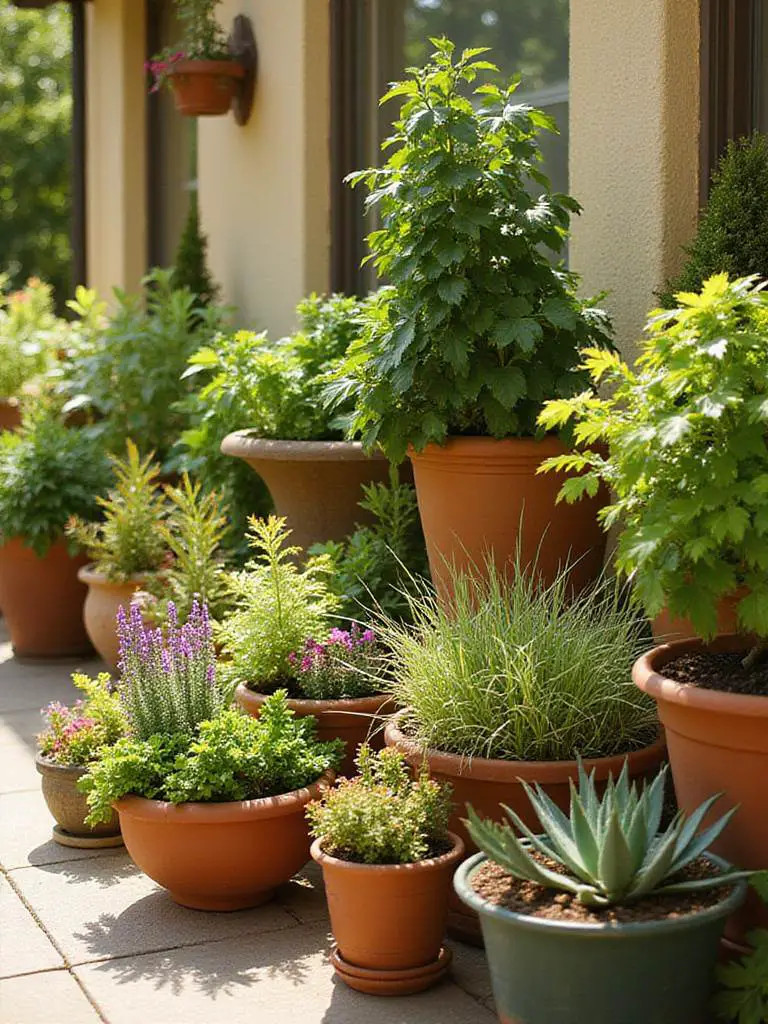
Beyond container compatibility, climate considerations are paramount. Your USDA Hardiness Zone determines which perennial plants can survive winter in your region. However, microclimate factors matter too – a south-facing patio against a brick wall creates a much warmer environment than a north-facing, shaded space. Consider summer heat intensity, humidity levels, and rainfall patterns when selecting plants.
The designer’s secret here is to choose plants that are rated for one zone colder than your actual zone when planning to overwinter containers outdoors. Container plants experience more extreme temperature fluctuations than in-ground plants, making them more vulnerable to cold damage in winter patio gardening situations.
7. Grow Edible Delights: Herbs, Veggies, and Fruits
After months of sourcing and curation, I’ve found that growing edibles on your patio delivers some of the most satisfying returns in container gardening. Fresh herbs like basil, mint, rosemary, and thyme thrive in pots and transform everyday cooking. Vegetables such as cherry tomatoes, lettuce, peppers, and bush beans produce impressive yields in limited space. Even fruits like strawberries and dwarf citrus can flourish in the right containers.
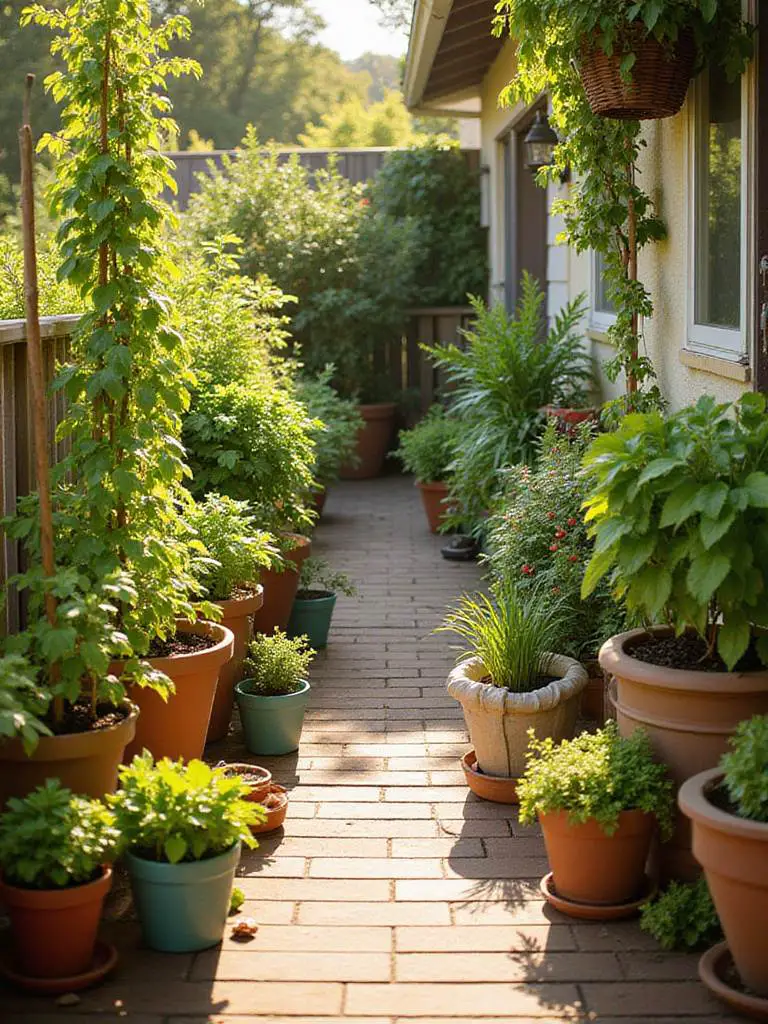
For edible patio gardening success, consider these essentials: most fruiting plants need at least 6-8 hours of direct sunlight daily; containers should be appropriately sized (deeper for root vegetables, wider for sprawling plants); and consistent moisture is critical during flowering and fruiting stages. Use high-quality potting mix enhanced with compost for edibles, as they’re often heavy feeders.
“The most mindful meal begins with herbs and vegetables you’ve tended yourself – connecting digital-age dining with ancient cultivation practices.” – Kai Nakamura
What surprises clients most is how this works with limited space – vertical gardening techniques like trellises for cucumbers or hanging baskets for strawberries maximize production while maintaining the clean aesthetic central to modern zen patio design.
8. Add Beauty with Flowering Annuals and Perennials
The revival of this classic form comes with a twist when designing a patio garden with flowers. Annuals complete their lifecycle in one season, offering immediate, often long-lasting color. Perennials return year after year, providing structure and consistency. Using both creates a dynamic space with reliable bones and seasonal flexibility.
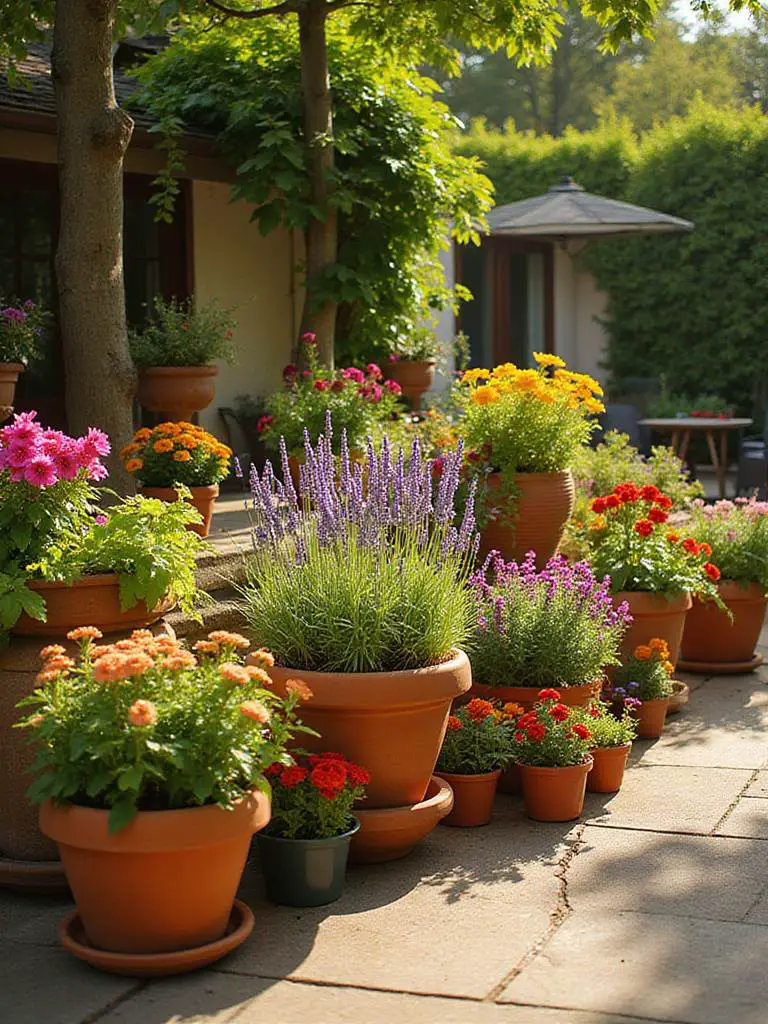
When selecting flowering plants for containers, consider bloom time to ensure continuous color, growth habit (upright, mounding, or trailing), and compatibility with neighboring plants. The “thriller, filler, spiller” approach works beautifully in larger containers – a tall, dramatic centerpiece plant, medium-height plants to fill the middle, and trailing varieties to cascade over the edges. This creates dimension and visual interest in your patio gardening design.
The composition comes together when you coordinate colors intentionally – monochromatic schemes for sophisticated elegance, complementary colors for vibrant energy, or analogous colors for harmonious transitions. Remember that foliage provides texture and color too, often with greater longevity than flowers themselves.
9. Consider Small Trees or Shrubs for Structure
The third-generation workshop where this comes to life understands that small trees and shrubs provide the architectural framework for exceptional patio gardens. These woody plants add height, structure, and year-round interest that seasonal plantings alone cannot achieve. They become focal points and space definers, transforming flat patios into three-dimensional garden rooms.
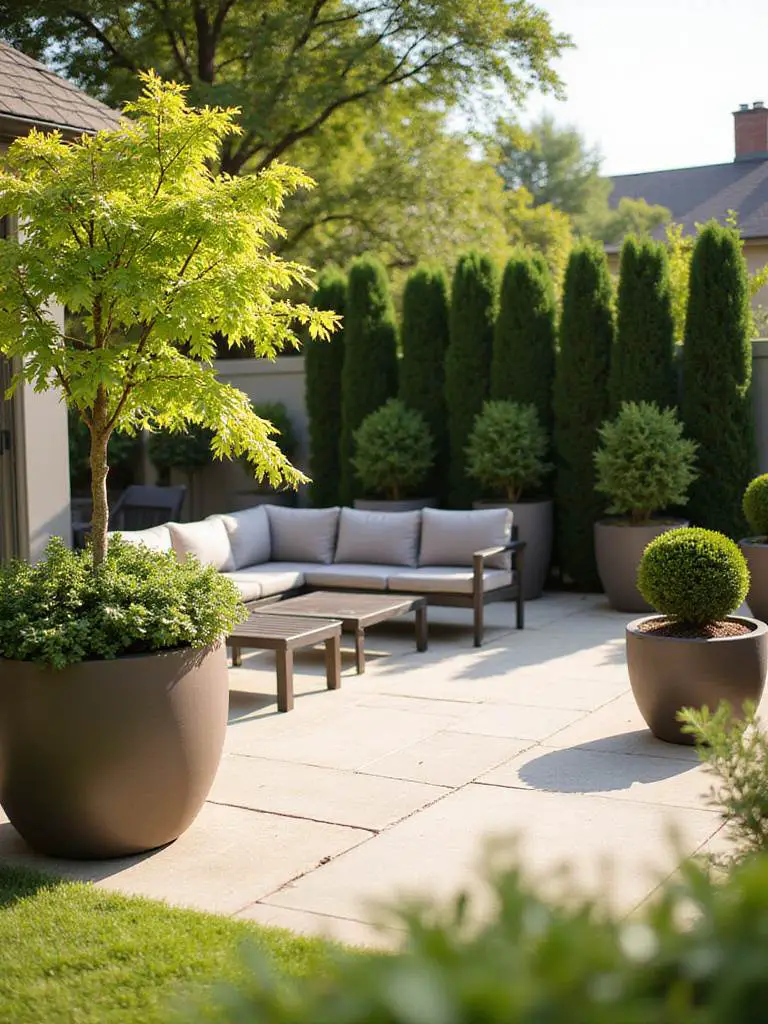
When selecting trees or shrubs for containers, look specifically for dwarf or slow-growing varieties to prevent them from quickly outgrowing their pots. Japanese maples, dwarf conifers, small citrus trees, and compact flowering shrubs like hydrangeas or azaleas work beautifully in patio gardening contexts. The container should be proportional to the plant’s mature size and provide adequate room for root development.
The traditional methods used result in a more stable microclimate around your patio – trees and shrubs buffer wind, provide dappled shade, and create humidity pockets that benefit neighboring plants. Their presence also attracts beneficial wildlife, adding another dimension of life to your outdoor space.
10. Embrace Vertical Gardening for Limited Space
The discovery of this technique happened when space constraints forced innovation in traditional Japanese gardens. Vertical gardening transforms walls, fences, and railings into growing surfaces, multiplying your planting area without consuming precious floor space. This approach is particularly valuable in small patio gardening situations where horizontal space is at a premium.
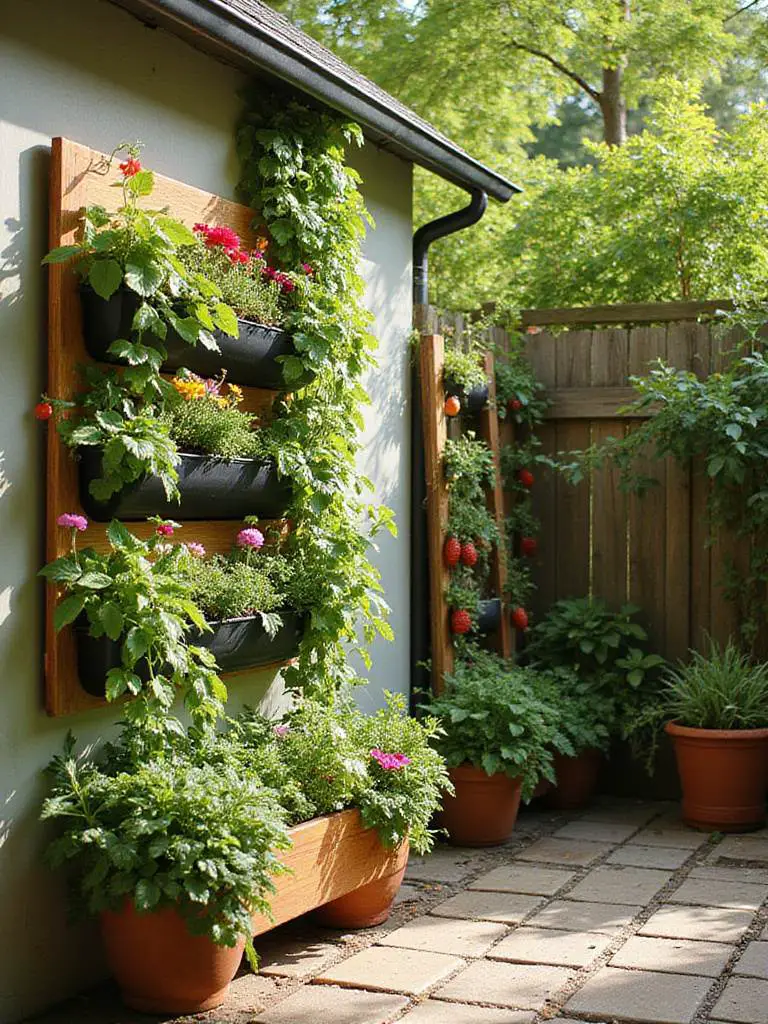
Vertical gardening options include wall-mounted planters, hanging baskets, trellises for climbing plants, tiered plant stands, and repurposed items like pallets or shoe organizers. Each creates different visual effects and accommodates different plant types. Consider the weight-bearing capacity of your mounting surface and ensure adequate water drainage that won’t damage walls or floors.
The cultural heritage preserved in each piece includes the Japanese principle of “ma” – the conscious use of negative space. Even in vertical designs, allowing some breathing room between plantings creates visual rest and highlights each plant’s unique form, bringing mindfulness to your patio gardening approach.
11. Group Plants with Similar Needs Together
Many homeowners wonder how to manage the diverse needs of different plants in a cohesive patio garden. The solution lies in strategic grouping – placing plants with similar requirements together. This creates microenvironments where each plant can thrive without compromising its neighbors’ health.
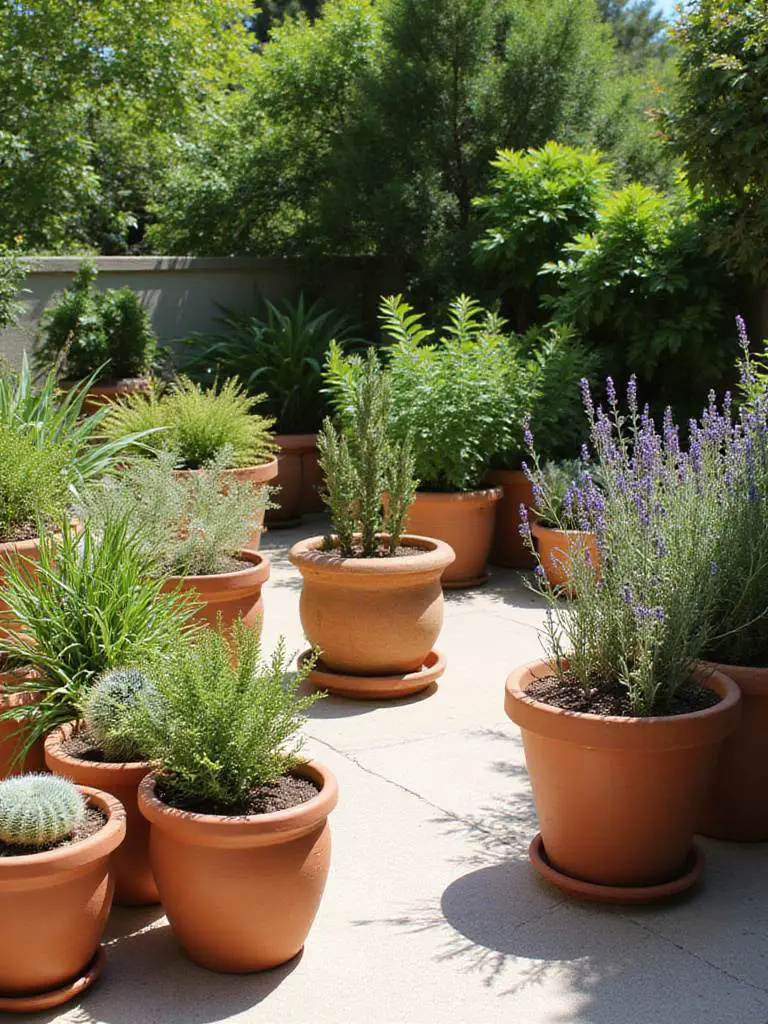
The primary factors for grouping include sunlight preferences (full sun, partial sun, shade), watering needs (drought-tolerant, moderate, moisture-loving), and fertilizer requirements (heavy feeders versus those preferring leaner conditions). This thoughtful arrangement simplifies maintenance significantly – you can water and feed each group appropriately without over or under-servicing any individual plant.
- Example plant groupings for patio gardening:
- Mediterranean Group: Lavender, rosemary, thyme, sage (full sun, low water)
- Tropical Corner: Coleus, ferns, caladiums, impatiens (shade, consistent moisture)
- Succulent Collection: Various sedums, echeverias, aloes (full sun, minimal water)
- Culinary Herb Cluster: Basil, parsley, cilantro, chives (sun to part shade, moderate water)
For those worried about maintenance, this zoning approach transforms patio gardening from a series of individual plant care tasks into a more holistic system where plants with similar needs support each other in designated areas.
12. Monitor for Pests and Diseases Regularly
What separates artisanal quality from mass-produced is the attention to detail, particularly in monitoring plant health. Regular inspection is your first line of defense against potential problems. Make it a habit to examine your plants weekly, looking closely at both upper and lower leaf surfaces, stems, soil, and container edges where pests often hide.
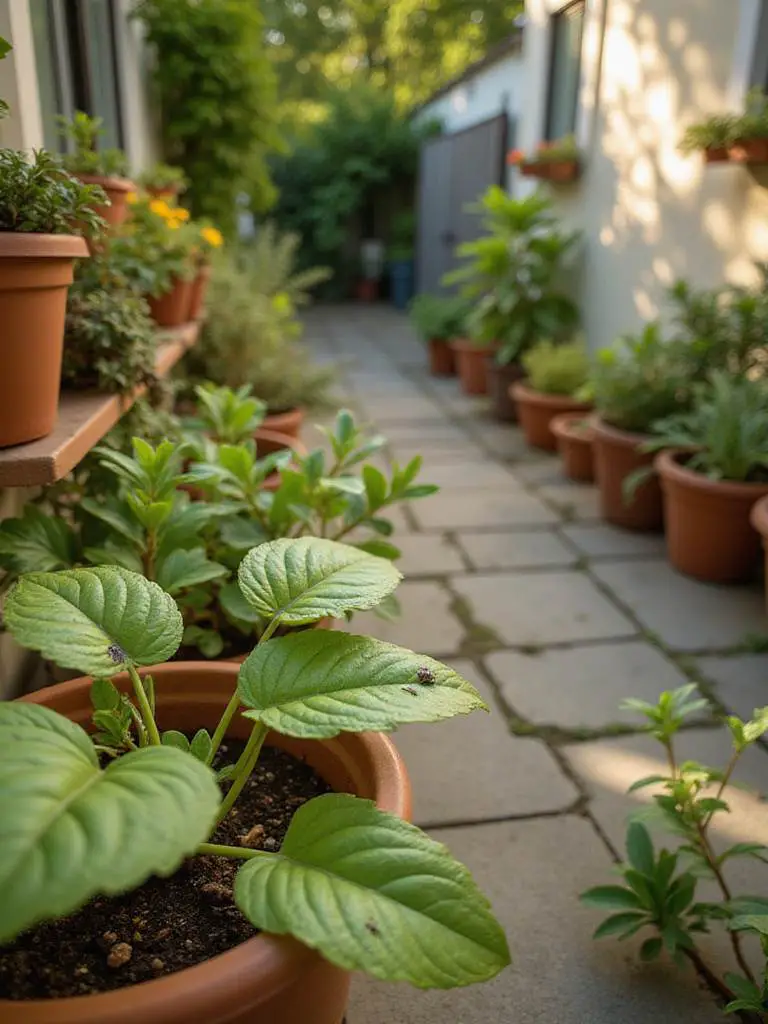
Early warning signs include discoloration, sticky residue, distorted growth, visible insects, webbing, holes or chewing damage, powdery substances, or wilting despite adequate soil moisture. Catching these issues early allows for gentler interventions – perhaps a strong spray of water to dislodge aphids or removing affected leaves – rather than resorting to stronger treatments later.
The unexpected environmental benefit comes from this vigilant monitoring, as it often eliminates the need for chemical pesticides in your patio gardening practice. Healthy plants in appropriate conditions naturally resist many problems, and prompt action when issues do arise prevents their spread throughout your container collection.
13. Use Mulch to Retain Moisture and Regulate Temperature
The interplay between the colors creates a beautiful effect, but mulch offers far more than aesthetic appeal in patio gardening. This simple top layer provides crucial functional benefits for container plants. It significantly reduces evaporation from the soil surface, meaning less frequent watering and more stable moisture levels for roots. It also moderates soil temperature, keeping roots cooler in summer heat and providing insulation against cold in winter.
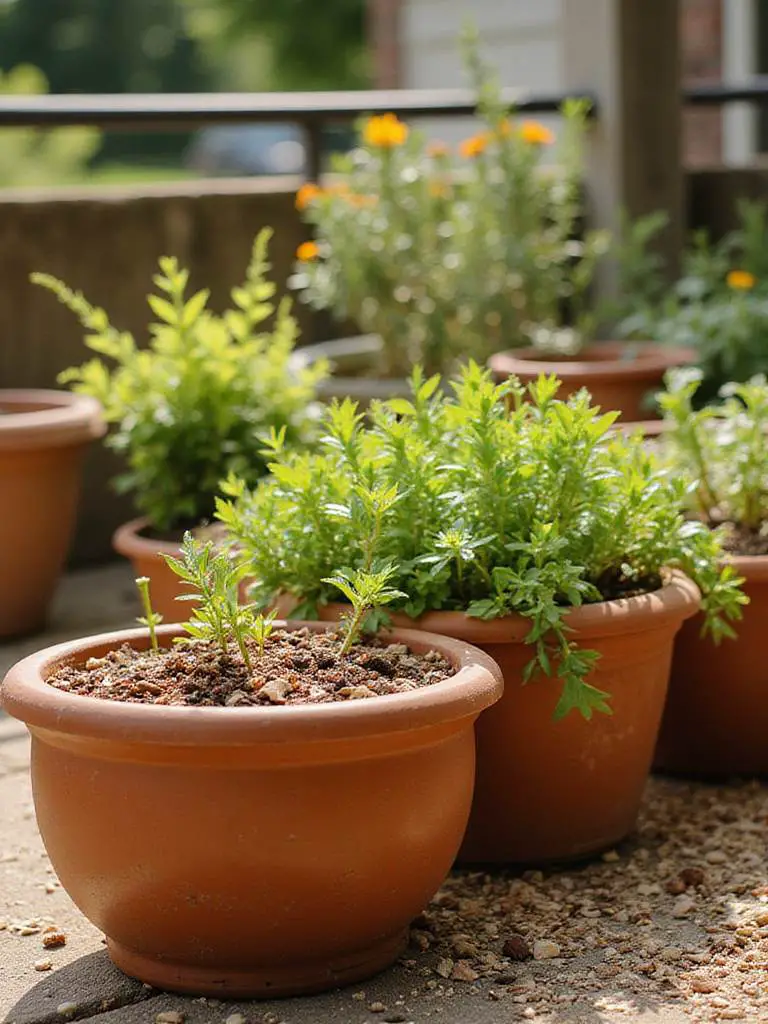
For most patio containers, a 1-2 inch layer of organic mulch like shredded bark, cocoa hulls, or compost works beautifully. Leave a small gap between the mulch and plant stems to prevent rot. Inorganic options like decorative pebbles or glass also work well, particularly in modern zen-inspired designs where their texture and color become part of the visual composition.
The tactile experience changes the entire room’s energy when you incorporate mulch thoughtfully into your patio gardening design. Beyond its practical benefits, the right mulch adds textural contrast and can visually unify diverse container plantings into a cohesive collection.
14. Prune and Deadhead for Healthier, More Productive Plants
When clients ask us about balancing style with comfort, pruning and deadheading emerge as essential techniques. These practices aren’t just about aesthetics – they fundamentally improve plant health and productivity. Pruning removes dead or crowded branches, improving air circulation and redirecting energy to healthy growth. Deadheading (removing spent flowers) encourages plants to produce more blooms rather than setting seed.
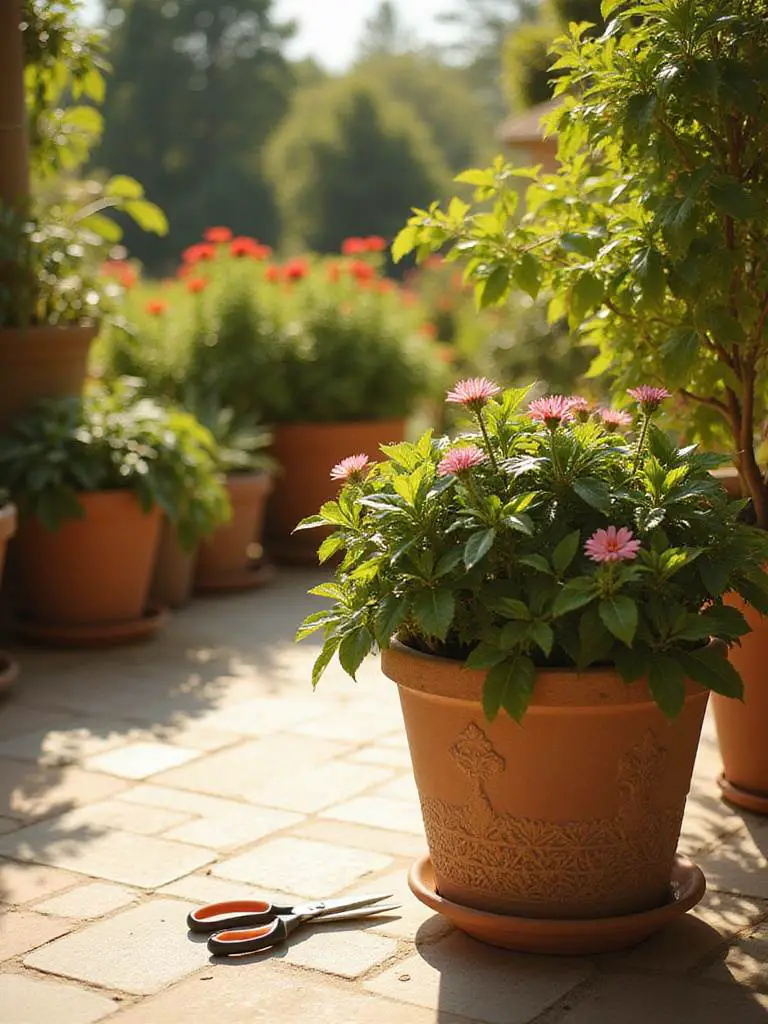
For most flowering annuals and perennials in your patio gardening collection, regular deadheading throughout the growing season will significantly extend the blooming period. Use clean, sharp scissors or pruners, or simply pinch with your fingers when appropriate. For woody plants like small trees or shrubs, timing matters – research your specific varieties to determine whether they bloom on new or old wood, which guides when to prune.
The silhouette draws inspiration from the Japanese practice of “niwaki” – the careful pruning that reveals a plant’s essential nature. Even in a small patio garden, thoughtful pruning creates intentional forms that bring both beauty and improved plant health to your outdoor space.
15. Think About Drainage Saucers (and How to Use Them Safely)
Beyond the obvious placement, consider using drainage saucers not just as functional items but as design elements in your patio gardening setup. These simple dishes catch excess water flowing from container drainage holes, protecting your patio surface from water damage, stains, and potential slip hazards. They’re particularly important on wooden decks, balconies, or indoor-outdoor spaces with finished flooring.
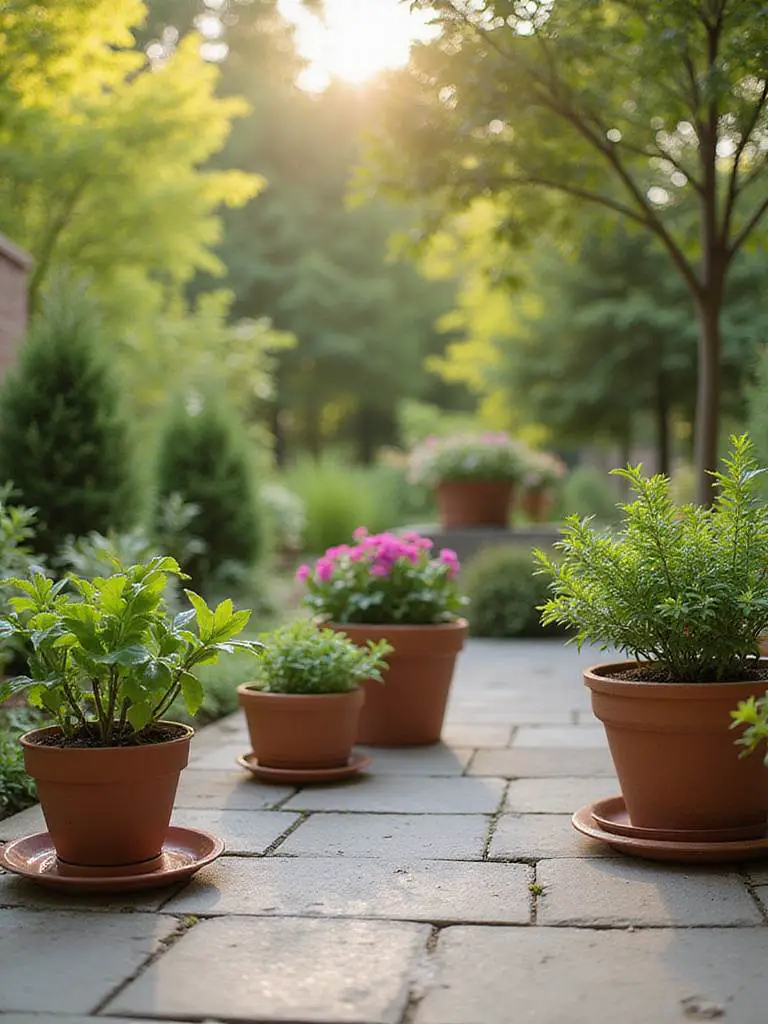
However, standing water in saucers creates risks – primarily root rot if plants sit in water too long. Check saucers after watering and empty any accumulated water after 30-60 minutes. For convenience, consider saucers with built-in risers that elevate the pot above the water collection area. Alternatively, place small stones in the saucer before setting the pot on top, creating a miniature humidity tray that benefits many plants without keeping roots wet.
The material sourcing makes all the difference in how these functional elements integrate with your design. Choose saucers that complement your containers – glazed ceramic for elegant pots, recycled plastic for sustainability, or hammered copper for an artisanal touch that develops beautiful patina over time in your patio gardening space.
16. Design for Aesthetics: Color, Texture, and Height
The forecast for next season already hints at the importance of intentional design in patio gardening. Creating a visually compelling container garden involves thoughtful consideration of color relationships, textural contrasts, and height variations. These elements transform a random collection of plants into a cohesive, professional-looking display.
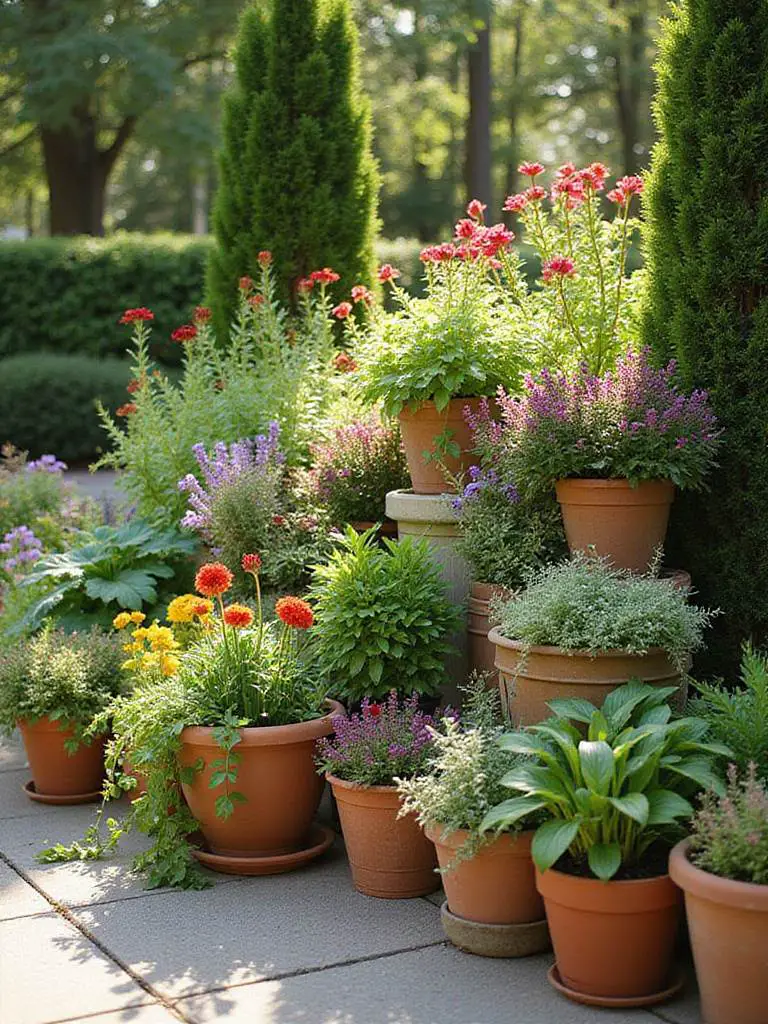
Color creates mood and energy – cool blues and purples recede and calm, while warm reds and oranges advance and energize. Texture adds tactile interest and depth – pairing fine, feathery foliage with bold, dramatic leaves creates dynamic contrast. Height variation prevents the flat, static look that comes from plants all at the same level – incorporate tall architectural elements, mid-height mounding forms, and cascading plants that spill over edges.
“Digital minimalism and garden design share a common principle – intentional choices create harmony. Remove what doesn’t serve the composition, highlight what does.” – Kai Nakamura
As morning light filters through, the texture creates ever-changing shadows and highlights across your patio garden, bringing the space to life throughout the day in ways that flat, one-dimensional designs cannot achieve.
17. Don’t Forget About Drainage in Your Patio Area
The challenge of awkward spaces becomes easier when you consider the overall drainage pattern of your patio itself, not just your containers. A patio that pools water during rain can create problems for your container garden – saturated pots, splashing that spreads fungal spores, and difficulty maintaining proper moisture levels. Ideally, your patio should have a slight slope (about 1/4 inch per foot) away from the house to direct water away.
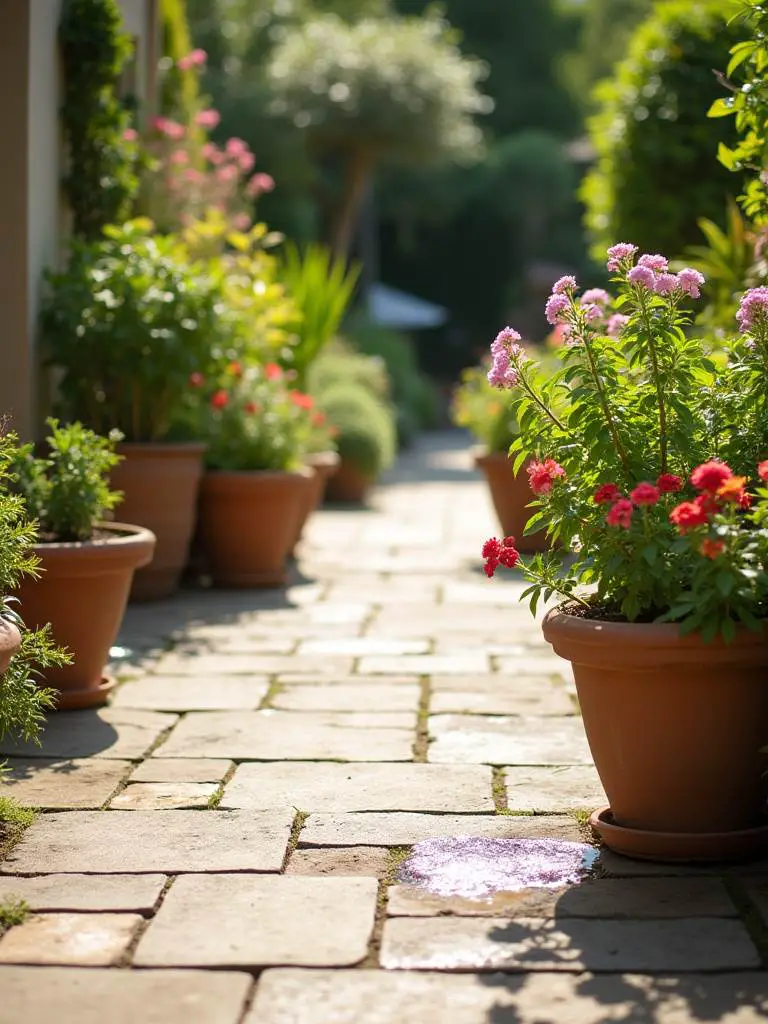
If your patio has drainage issues, create solutions that work with your patio gardening design. Elevate containers on decorative stands or casters to prevent them from sitting in puddles. Consider installing channel drains or creating gravel drainage areas in problem spots. For serious pooling, consult a professional about adjusting the patio slope or adding drainage systems.
If you’ve struggled with similar rooms before, remember that proper drainage both within containers and on the patio surface itself creates the foundation for success. Plants that alternate between soggy roots and drought stress rarely thrive, making this unglamorous aspect of patio gardening one of the most important to address.
18. Plan for Overwintering or Replacing Plants
The sustainable journey of this material involves thinking seasonally about your patio garden, especially in climates with cold winters. Container plants are more vulnerable to freezing temperatures than those in the ground because their roots lack the insulation of surrounding soil. Having a winter plan for each plant is essential for year-round patio gardening success.
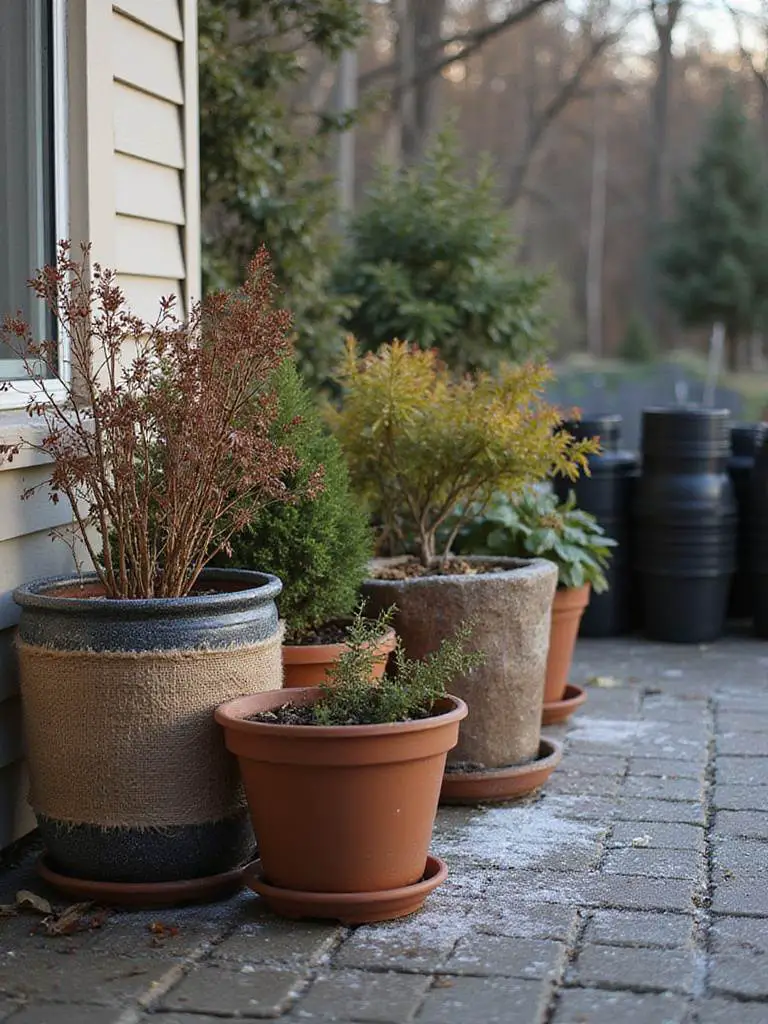
You have three main options for winter: bring tender plants indoors (to a sunny window, sunroom, or under grow lights), provide protection outdoors (grouping pots, wrapping containers, moving to sheltered locations), or treat certain plants as annuals to be replaced next season. The right choice depends on the plant’s cold hardiness, your available indoor space, and your budget and preferences.
- Overwintering preparation checklist:
- Research each plant’s cold hardiness relative to your zone
- Stop fertilizing 6-8 weeks before first expected frost
- Gradually reduce watering as temperatures cool
- Check for and treat any pests before bringing plants indoors
- Prepare indoor spaces with appropriate light and humidity
- Gather materials for insulating outdoor containers (bubble wrap, burlap, mulch)
The visual weight balances perfectly when you plan for year-round interest in your patio gardening design, ensuring the space remains inviting even during dormant seasons.
19. Incorporate Companion Planting Principles
Even in smaller spaces, here’s how companion planting works to enhance your patio gardening success. This ancient practice involves growing compatible plants together for mutual benefit – pest deterrence, improved growth, enhanced flavor, or more efficient use of space. In containers, these relationships become even more valuable due to the concentrated growing environment.
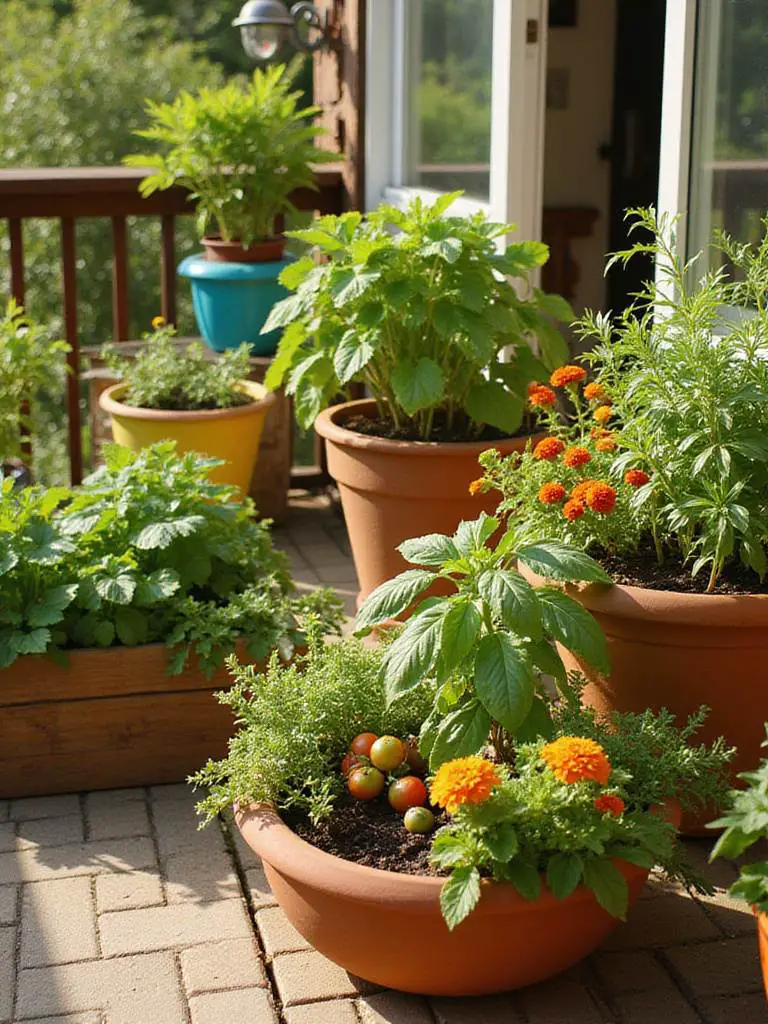
Classic companions that work well in patio containers include tomatoes with basil (improved flavor and growth for both), marigolds with vegetables (pest deterrence), herbs with compatible vegetables, and flowers that attract pollinators alongside fruiting plants. Beyond the practical benefits, thoughtful combinations create visually appealing arrangements that serve multiple purposes – beauty, function, and ecological balance.
The maker’s journey from apprentice to master influenced this integrated approach to patio gardening, where each plant serves multiple roles in the garden ecosystem. A container with companion plants becomes more than the sum of its parts – a miniature, self-supporting community that requires less intervention while producing more beauty and bounty.
20. Enjoy Your Oasis: Make Time to Relax and Appreciate
Imagine coming home to the gentle glow of evening light playing through your patio garden, highlighting leaf textures and casting soft shadows. After all your planning and care, the most important aspect of patio gardening is taking time to enjoy the space you’ve created. This isn’t just a nice bonus – it’s essential for your wellbeing and for maintaining your connection to the garden.
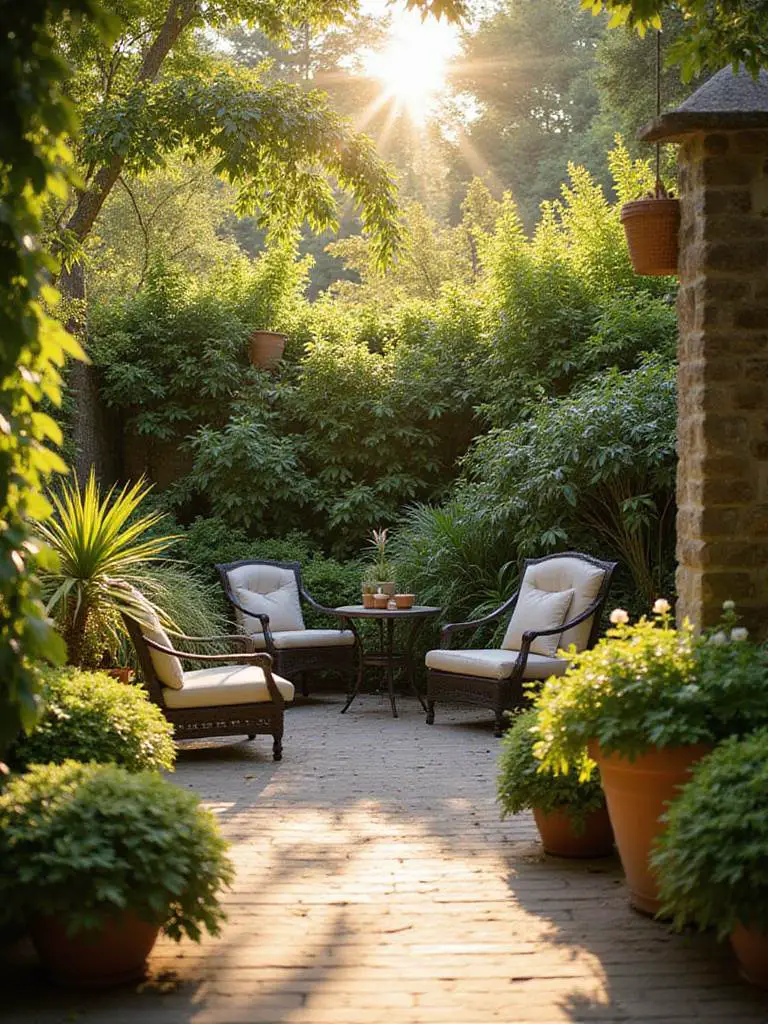
Schedule short periods to simply sit and observe your patio garden. Notice seasonal changes, new growth, visiting pollinators, and the way light interacts with plants throughout the day. These moments of mindful observation not only reduce stress but also help you become a better gardener as you develop greater awareness of your plants’ needs and responses.
The emotional response this evokes begins with intentional presence – creating a comfortable seating area, perhaps with a small table for tea or a journal, invites you to linger. In our digital-dominated lives, these moments of connection with living plants provide a crucial counterbalance, bringing traditional zen principles of mindfulness into modern patio gardening practice.
Conclusion
Your patio garden represents a perfect fusion of ancient wisdom and modern needs – a space where traditional growing techniques meet contemporary design sensibilities. By implementing these 20 essential tips, you’ve created more than just an attractive outdoor area; you’ve established a living sanctuary that nourishes both body and spirit.
Remember that patio gardening, like all worthwhile pursuits, is a journey rather than a destination. Each season brings new learning opportunities and chances to refine your approach. Embrace both successes and challenges as part of the process. The mindful attention you bring to your container plants creates a reciprocal relationship – as you nurture them, they provide beauty, possibly food, and most importantly, moments of connection to the natural rhythms that ground us in our increasingly digital world.
Your modern zen patio garden now stands as a testament to intentional design – a space where technology recedes, nature takes center stage, and the ancient art of cultivation meets contemporary life in perfect harmony.
